
Some plays simply cannot be updated to the 21st Century. Take for example Wait Until Dark, Frederick Knott’s classic 1966 thriller about a blind New York City newlywed targeted by a trio of thugs out to find the heroin-filled doll they believe to be hidden somewhere in the walk-down flat she shares with her photographer husband—a play entirely dependent on there being just one land-line phone in the apartment and a (now virtually non-existent) phone booth on a nearby corner.
That’s why, when I heard that playwright Jeffrey Hatcher was adapting Wait Until Dark for the Geffen Playhouse “in a new time/setting,” my first thought was “They must be kidding!” Then I found out that Hatcher was actually taking Knott’s thriller back in time to WWII New York City and that thought turned to “Wow! What a clever idea!” Not only a clever idea, it turns out, but one that proves as exiting in execution as in theory.
Now there will be those who’ll say, “If it ain’t broke, don’t fix it,” and Knott’s original surely ain’t broke. Still, for those who’ve seen umpteen productions (and even for those discovering WUD for the first time), the 1940s time frame makes Knott’s play seem fresh and new in a way that yet another groovy ‘60s revival would not.
The cast of characters, plotline, and indeed the play’s setting have not changed, though “Susy” is now a less ‘60s-trendy “Susan” (and Hatcher has figured out how to eliminate two of the most thankless teensy-weensy roles ever written for the stage, a smart move in these tighter-budgeted times).
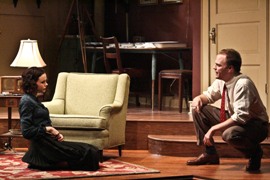 Wait Until Dark fans know the set-up. Having reason to believe that a particularly valuable doll has been hidden inside the apartment of photographer Sam Hendrix (Matt McTighe) and his wife Susan (Alison Pill), professional crook Harry Roat (Adam Stein) concocts a fiendishly clever plot to take possession of said doll even if it means committing another murder. That’s right. Another murder.
Wait Until Dark fans know the set-up. Having reason to believe that a particularly valuable doll has been hidden inside the apartment of photographer Sam Hendrix (Matt McTighe) and his wife Susan (Alison Pill), professional crook Harry Roat (Adam Stein) concocts a fiendishly clever plot to take possession of said doll even if it means committing another murder. That’s right. Another murder.
And so, with the help of policeman-turned-ex-con Sergeant Carlino (Rod McLachlan), Roat sets his complicated plan in motion, one involving Carlino’s posing as an NYPD detective and Roat’s assuming a pair of disguises.
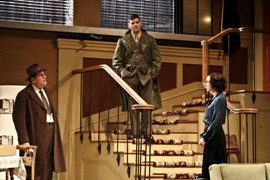 With Mike away on a job and Susan left home alone to fend for herself, the arrival of Mike’s former Army buddy Mike Tallman (Mather Zickel) offers our heroine a valuable ally in addition to precocious (if a tad bratty) preteen upstairs neighbor Gloria (Brighid Fleming).
With Mike away on a job and Susan left home alone to fend for herself, the arrival of Mike’s former Army buddy Mike Tallman (Mather Zickel) offers our heroine a valuable ally in addition to precocious (if a tad bratty) preteen upstairs neighbor Gloria (Brighid Fleming).
As was true in 1966, this 1944 Wait Until Dark gets its title from the play’s most famous scene, one in which its blind damsel-in-distress finds herself trapped in her apartment with a vicious murderer and decides to even the odds by placing not only herself but also the killer (and the audience) in pitch blackness.
And more than any Wait Until Dark I’ve seen before, its Geffen revival delivers the goods in a doozy of a grand finale that will have you grabbing the nearest available hand for dear life.
Some of Hatcher’s revisions help situate this Wait Until Dark in 1944 New York. The doll is no longer filled with heroin, but something a bit more appropriate to the era. War photographer Sam met recent accident victim Susan while hospitalized for what we’d now call PTSD at the same time as his future wife’s bones were healing from the car crash that cost her her sight. Another bit of script doctoring gives Gloria a very good reason for “acting out.” In his best tweak of all, Hatcher withholds one significant bit of information throughout most of Act One, making for one humginger of of a pre-intermission surprise, judging from audience reaction. (Future productions should keep this one in regardless of “time zone.”)
The WWII setting gives this Wait Until Dark a swell new 1940s look thanks to E.B. Brooks’ vintage costumes and Craig Siebels finely detailed set. (The constant drizzle outside at street level is a noteworthy plus, though I’d like to recommend replacing Sam and Susan’s anachronistic curly phone cord.) Not surprisingly, foremost among design elements are Elizabeth Harper’s dramatic lighting and Jonathan Snipes’ pulsating sound design and original music, both of which up the suspense ante to the nth degree.
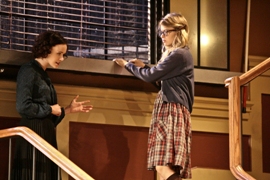 Performances too are as good as it gets under Matt Shakman’s incisive direction. Pill is the very personification of spunk even as the initially calm-and-collected Susan becomes increasingly frightened and frazzled by the realization of just how much danger she is in. (If Pill seems to move rather swiftly around her apartment for someone without sight, Susan has after all had a year to commit the carefully arranged space to heart.) In Harry Roat, Stein undertakes one of the creepiest villains ever and does so to perfection, whether disguised as Harry Roat, Sr. or Harry Jr., or dressed merely to kill, underplaying Roat’s evil to make it all the more terrifying. Zickel has just the right good-guy quality to make for a terrific Mike, McLachlan’s marvelous Carlino is the quintessential good cop gone bad, Fleming is an absolute delight as Susan’s eager accomplice in outwitting the bad guys, and McTighe makes for a sympathetic Sam in his brief scenes as Susan’s one-man support system.
Performances too are as good as it gets under Matt Shakman’s incisive direction. Pill is the very personification of spunk even as the initially calm-and-collected Susan becomes increasingly frightened and frazzled by the realization of just how much danger she is in. (If Pill seems to move rather swiftly around her apartment for someone without sight, Susan has after all had a year to commit the carefully arranged space to heart.) In Harry Roat, Stein undertakes one of the creepiest villains ever and does so to perfection, whether disguised as Harry Roat, Sr. or Harry Jr., or dressed merely to kill, underplaying Roat’s evil to make it all the more terrifying. Zickel has just the right good-guy quality to make for a terrific Mike, McLachlan’s marvelous Carlino is the quintessential good cop gone bad, Fleming is an absolute delight as Susan’s eager accomplice in outwitting the bad guys, and McTighe makes for a sympathetic Sam in his brief scenes as Susan’s one-man support system.
Fight director Ned Mochel gets top marks for a particularly exhausting knock-down, drag-out. Elizabeth Himelstein is dialect coach and Amy Levinson dramaturg. Casting is by Phillis Schuinga, CSA. James T. McDermott is production stage manager and Susie Walsh assistant stage manager.
Past productions have proven Wait Until Dark’s ability to involve and thrill regardless of theater size or production budget. Still, it’s particularly exciting to see it staged on the great big Geffen stage with the bucks to make this Wait Until Dark look and sound quite sensational indeed. That Hatcher’s adaptation of Knott’s classic thriller actually improves on the original is icing on the cake.
Geffen Playhouse, 10886 Le Conte Ave., Westwood.
www.geffenplayhouse.com
–Steven Stanley
October 17, 2013
Photos: Michael Lamont
Tags: Frederick Knott, Geffen Playhouse, Jeffrey Hatcher, Los Angeles Theater Review, Wait Until Dark

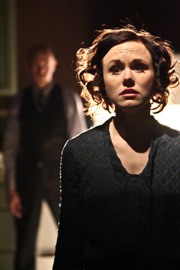
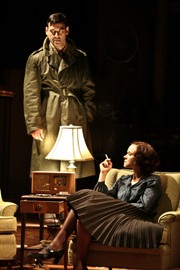
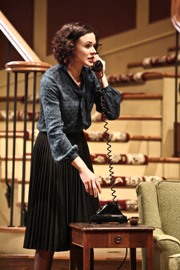
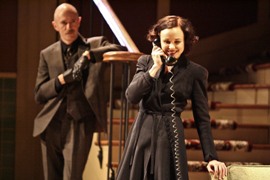

 Since 2007, Steven Stanley's StageSceneLA.com has spotlighted the best in Southern California theater via reviews, interviews, and its annual StageSceneLA Scenies.
Since 2007, Steven Stanley's StageSceneLA.com has spotlighted the best in Southern California theater via reviews, interviews, and its annual StageSceneLA Scenies.







 COPYRIGHT 2025 STEVEN STANLEY :: DESIGN BY
COPYRIGHT 2025 STEVEN STANLEY :: DESIGN BY